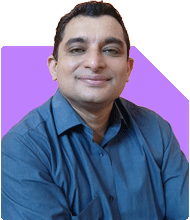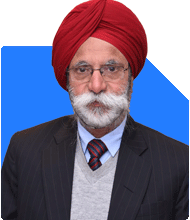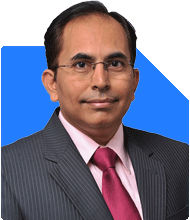Ramalingam Kalirajan |10902 Answers |Ask -Follow
Mutual Funds, Financial Planning Expert - Answered on Jun 25, 2024
He has an MBA in finance from the University of Madras and is a certified financial planner.
He is the director and chief financial planner at Holistic Investment, a Chennai-based firm that offers financial planning and wealth management advice.... more

I'm 22, final year student. I receive a small amount of money of 70K from my college scholarships every year, as my all 3 years I have been handing over the amount to my parents but this year I am planning to invest this bunch of money. Please advice whether it shall be in equity stocks or MFs or ETFs.
Understanding Your Investment Options
You have several choices for investing your money: Equity Stocks, Mutual Funds (MFs), and Exchange Traded Funds (ETFs). Each option has its pros and cons. Your decision should depend on your financial goals, risk tolerance, and investment horizon.
Equity Stocks:
Investing directly in stocks means buying shares of companies. This can offer high returns, but it also comes with high risk. You need to research and understand the market well to make good stock picks.
Mutual Funds (MFs):
Mutual Funds pool money from many investors to buy a diversified portfolio of stocks, bonds, or other securities. They are managed by professionals and can be actively or passively managed. MFs are a good option if you prefer professional management and diversification.
Exchange Traded Funds (ETFs):
ETFs are like mutual funds but trade on stock exchanges like individual stocks. They often track an index and offer a low-cost way to invest in a diversified portfolio. However, they typically do not have active management, which can limit their potential for higher returns compared to actively managed funds.
Evaluating Each Option
Let's break down each option to understand which might be best for you.
Investing in Equity Stocks
High Potential Returns: Stocks can provide significant returns, especially if you pick strong, growing companies. However, they can also be volatile and risky.
Requires Market Knowledge: Successful stock investing requires good research, understanding of the market, and the ability to handle market ups and downs. It can be time-consuming and stressful for a new investor.
High Risk: If the market or a specific company performs poorly, your investment can lose value quickly.
Recommendation: If you have a keen interest in learning about the stock market and can devote time to research, investing a small portion in stocks could be beneficial. But for most new investors, starting with mutual funds or ETFs is safer.
Investing in Mutual Funds (MFs)
Professional Management: Mutual funds are managed by experts who select and manage a diversified portfolio. This reduces your effort and risk.
Diversification: MFs invest in a variety of assets, spreading out risk. You benefit from diversification even with a small investment.
Suitable for All Investors: Whether you prefer equity funds for growth, debt funds for stability, or balanced funds for a mix, there's a mutual fund for every risk appetite.
Recommendation: MFs are an excellent choice for new investors. They provide professional management and diversification, reducing your risk and effort.
Investing in Exchange Traded Funds (ETFs)
Low Cost: ETFs usually have lower expense ratios than mutual funds because they are often passively managed, tracking an index.
Liquidity and Flexibility: ETFs can be bought and sold like stocks throughout the trading day, offering more flexibility.
Lower Potential for Outperformance: Since many ETFs simply track an index, they may not outperform the market. Active management can offer better returns in certain conditions.
Recommendation: ETFs can be a good option for cost-conscious investors who want flexibility and ease of trading. However, they may not provide the same potential for outperformance as actively managed funds.
Choosing the Right Path: Equity Stocks, Mutual Funds, or ETFs?
Given your age and situation, here's a balanced approach to consider:
Start with Mutual Funds:
Mutual Funds are ideal for beginners due to their professional management and diversification. You can choose funds based on your risk appetite. For example, equity funds for higher growth or balanced funds for moderate risk.
Consider ETFs for Low-Cost Diversification:
ETFs offer low-cost diversification and can be a good addition to your portfolio. They provide a way to invest in a broad market index with lower fees.
Explore Stocks Gradually:
If you're interested in learning about the stock market, start with a small portion of your investment. Over time, as you gain knowledge, you can allocate more to direct stock investments.
Building Your Investment Strategy
Let’s discuss how you can allocate your Rs. 70,000 across these options to create a balanced portfolio.
Allocate to Mutual Funds:
Start by investing a significant portion, say Rs. 40,000, in mutual funds. Choose a mix of funds that align with your risk tolerance and goals. For example, you might select a combination of large-cap, mid-cap, and balanced funds.
Add ETFs for Diversification:
Invest Rs. 20,000 in ETFs. Choose ETFs that provide broad market exposure, such as those tracking large indices. This gives you low-cost diversification with easy trading options.
Small Allocation to Stocks:
With the remaining Rs. 10,000, you can dip your toes into the stock market. Pick a few stable, well-researched companies. This will give you a taste of direct equity investing without risking too much capital.
Benefits of Actively Managed Funds
When investing in mutual funds, you might wonder whether to choose actively managed funds or passive options like index funds. Here’s why actively managed funds could be a better choice:
Potential for Outperformance:
Active fund managers use research and expertise to select stocks that can outperform the market. They aim to beat the index returns, offering higher growth potential.
Flexibility in Strategy:
Actively managed funds can adapt to market conditions, shifting investments to sectors or stocks that are expected to perform well. This flexibility can enhance returns.
Risk Management:
Professional fund managers actively manage risks by adjusting the fund's portfolio based on market trends. This can help protect your investment during market downturns.
Advantages of Investing Through a Certified Financial Planner (CFP)
You might consider direct plans of mutual funds due to their lower cost, but investing through a Certified Financial Planner has distinct advantages:
Expert Guidance:
CFPs provide tailored advice based on your financial goals and risk tolerance. They help you choose the right funds and investment strategy.
Portfolio Management:
CFPs assist in building and managing your portfolio, ensuring it aligns with your objectives. They help with regular reviews and rebalancing.
Comprehensive Financial Planning:
Beyond investments, CFPs offer guidance on overall financial planning, including savings, insurance, and tax strategies. This holistic approach is invaluable.
Final Insights
Investing your Rs. 70,000 scholarship wisely can set the foundation for your financial future. Here’s a summary of the steps to take:
Prioritize Mutual Funds:
Start with mutual funds for their professional management and diversification. They offer a safe entry into investing.
Add ETFs for Cost Efficiency:
Include ETFs for low-cost, broad market exposure. They provide flexibility and liquidity while keeping costs low.
Explore Direct Stocks Cautiously:
If interested, invest a small portion in direct equity. This helps you learn without taking on too much risk.
Consider Active Management:
Actively managed funds can provide higher returns and better risk management compared to index funds.
Seek CFP Guidance:
Investing through a Certified Financial Planner offers expert advice, portfolio management, and comprehensive financial planning.
Starting early with a balanced approach will help you grow your wealth over time. Your decision to invest your scholarship shows great foresight. Continue learning and stay disciplined in your investment journey.
Best Regards,
K. Ramalingam, MBA, CFP,
Chief Financial Planner,
www.holisticinvestment.in
You may like to see similar questions and answers below
Sudhanshu Singh | Answer |Ask -Follow
Answered on Apr 12, 2022
Ramalingam Kalirajan |10902 Answers |Ask -Follow
Mutual Funds, Financial Planning Expert - Answered on Aug 21, 2024
Ramalingam Kalirajan |10902 Answers |Ask -Follow
Mutual Funds, Financial Planning Expert - Answered on Feb 27, 2025
Ramalingam Kalirajan |10902 Answers |Ask -Follow
Mutual Funds, Financial Planning Expert - Answered on Jun 20, 2025
Anu Krishna |1749 Answers |Ask -Follow
Relationships Expert, Mind Coach - Answered on Dec 17, 2025
Anu Krishna |1749 Answers |Ask -Follow
Relationships Expert, Mind Coach - Answered on Dec 17, 2025
Radheshyam Zanwar |6748 Answers |Ask -Follow
MHT-CET, IIT-JEE, NEET-UG Expert - Answered on Dec 17, 2025
Anu Krishna |1749 Answers |Ask -Follow
Relationships Expert, Mind Coach - Answered on Dec 17, 2025
Dr Shakeeb Ahmed Khan |184 Answers |Ask -Follow
Physiotherapist - Answered on Dec 17, 2025
T S Khurana |538 Answers |Ask -Follow
Tax Expert - Answered on Dec 17, 2025
T S Khurana |538 Answers |Ask -Follow
Tax Expert - Answered on Dec 17, 2025
Janak Patel |72 Answers |Ask -Follow
MF, PF Expert - Answered on Dec 17, 2025
Ramalingam Kalirajan |10902 Answers |Ask -Follow
Mutual Funds, Financial Planning Expert - Answered on Dec 17, 2025
Samraat Jadhav |2511 Answers |Ask -Follow
Stock Market Expert - Answered on Dec 17, 2025



























